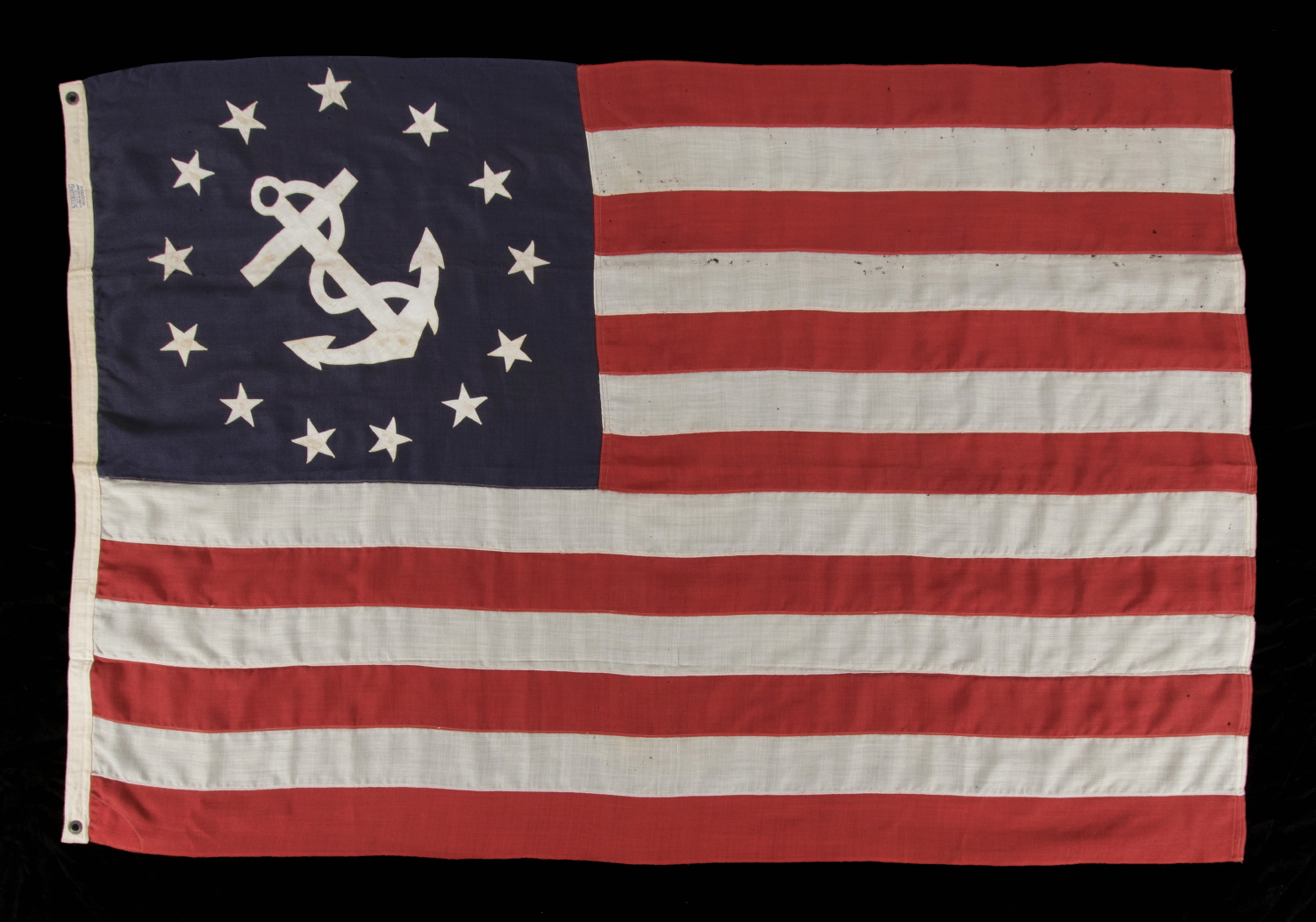
| |
13 STAR PRIVATE YACHT ENSIGN IN AN UNUSUALLY LARGE SCALE FOR THIS STYLE OF FLAG, MADE BY ANNIN IN NEW YORK CITY, 1910-1920'S ERA |
|
| Available: |
Sold |
| Frame Size (H x L): |
|
| Flag Size (H x L): |
47.5" x 70" |
|
| Description....: |
|
13 STAR PRIVATE YACHT ENSIGN IN AN UNUSUALLY LARGE SCALE FOR THIS STYLE OF FLAG, MADE BY THE ANNIN COMPANY OF NEW YORK & NEW JERSEY circa 1910-1920's:
The medallion configuration, 13-star, 13-stripe flag with a canted center anchor was entered into official use in 1848, following an act of Congress, that made it the official signal for U.S. pleasure sailing vessels. The need for such a flag arose with the popularity of boating as a pastime for well-to-do Americans, and as a competitive sport, in addition to its longstanding utilitarian role as a vehicle of trade. In early America, all boats were subject to customs searches at every port. Without modern income tax, the federal government derived its revenues mostly from tariffs, so an accounting of foreign goods on ships was a critical venture. As yachting for pleasure became more prevalent, however, more and more time was spent searching boats that had no such inventory, wasting time for both customs officials and wealthy ship owners.
John Cox Stevens (1775 - 1857), one of the most important members of New York society, was responsible for bringing this flag to fruition. Stevens was the paternal grandson of John Stevens Jr., New Jersey delegate to the Second Continental Congress, and the son of Revolutionary War officer, Colonel John Stevens, a pioneer in the development of steamboats and purchaser of what is now the City of Hoboken. Among other ventures, John Cox Stevens served as president of the Jockey Club (United Kingdom), was a founding member and 2nd president of New York's Union Club (est. 1836), and founding Commandant of the New York Yacht Club (elected 1844/est. 1845). He was part of the syndicate that own the yacht "America," which, in 1851, won the trophy that would eventually be named in its honor, the America's Cup.
In 1847, Stevens approached the secretary of the treasury and suggested that something be done to streamline the customs process for non-trade vessels. In 1848, legislation passed Congress requiring registration of these boats, which could then fly the “American Yachting Signal” to bypass customs. This remained on the books until the 1980’s. Though the 1848 legislation was revoked, flags in this design, flown for decorative function, continues to this day.
The canton and the stripes of the flag are made of wool bunting that has been pieced with machine stitching. The stars and anchor are made of cotton and are double-appliquéd with a zigzag machine stitch. This type of stitch was patented for use on flags in 1892 and quickly became the most common way to appliqué stars and remained so until after WWII. The triangular gussets (reinforced patches) at the top and bottom corners of the hoist end are original to the flag's construction.
There is a heavy canvas binding along the hoist, with two brass grommets, along which there is a maker's label that reads: "Sterling; Reg. U.S. Pat. Off.; All Wool Double Warp Bunting," accompanied by a blue-inked stamp that reads "4 x 6" to indicate the size in feet. The brand name seems to have appeared sometime during the 19-teens and this particular example was probably made sometime between then and the 1920's.
Annin is our nation's eldest flag-maker that is still in business today. The company was founded in the 1820's on the New York waterfront, incorporated in 1847, and, though it opened a large manufacturing operation in Verona, New Jersey in 1916, maintained its head office and some production in Manhattan until 1960. Sterling was a trademark for Annin’s highest grade of wool bunting (with one possible exception, if I am not mistaken).
13 star flags have been used throughout our nation's history for a variety of purposes. In addition to their use on private yachts, the U.S. Navy used the 13 star count on small boats, both in the 18th century and through most or all of the 19th century, particularly the second half. The Navy’s use of the 13 star flag ended in 1916 following an executive order written by President Woodrow Wilson. Among other uses, 13 star flags were carried by soldiers during the Mexican and Civil Wars, used at patriotic events, including Lafayette’s visit in 1825-26, flown at the celebration of the nation’s centennial in 1876 and the sesquicentennial in 1926.
Mounting: The flag has not yet been mounted. We employ professional staff with masters degrees in textile conservation and can attend to all of your mounting and framing needs.
Condition: There is minor mothing throughout, accompanied by minor foxing and staining in the stars and anchor. Many of my clients prefer early flags to show their age and history of use. |
|
|
|
| Collector Level: |
Beginners and Holiday Gift Giving |
|
| Flag Type: |
Sewn flag |
|
| Star Count: |
13 |
|
| Earliest Date of Origin: |
1910 |
|
| Latest Date of Origin: |
1930 |
|
| State/Affiliation: |
13 Original Colonies |
|
| War Association: |
|
|
| Price: |
SOLD |
|
| |
Views: 5329 |
|
|
|

